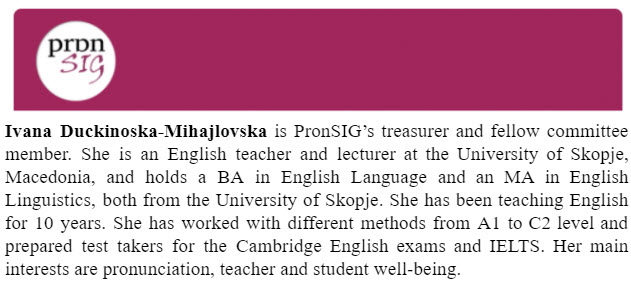by Ivana Duckinoska-Mihajlovska
As English continues to dominate as a global language, the interaction landscape has changed dramatically. The number of non-native speakers (NNS) of English is overtaking the number of native speakers (NS), meaning that English is frequently used as a tool for communication between NNSs (Hancock, 2022). This shift has influenced research in English as a Second Language (ESL) and English as a Foreign Language (EFL), prompting the introduction of the Lingua Franca Core (Jenkins, 2000). This framework provides recommendations on which pronunciation features should be targeted in the ESL/EFL classroom to ensure intelligible communication among NNSs. This list does not include the production of connected speech as this is a feature which can reduce rather than enhance international intelligibility. A more recent resource, Teaching English Pronunciation for a Global World (Walker & Archer, 2024), offers further research-informed practices for teaching English pronunciation with an emphasis on international intelligibility. For more information on key terms such as intelligibility, ELF and others, check this previous blog post.
However, incorporating work on connected speech can be helpful for some students, especially when taught receptively to support listening comprehension. Some teachers may still want to use native accents as speech models in the classroom, preparing learners for communication with NSs as well. In such cases, it is crucial that learners understand the nature of the English rhythm. In fact, the rhythmic organisation of the English language is such that some words receive more prominence, while others can be reduced, combined with other sounds or even disappear altogether. This leads to connected speech processes, where words in spoken English deviate from the forms we see in the dictionary. Various course books may include slightly different classifications of connected speech features; nevertheless, they generally include the following common changes:
- Assimilation: This process occurs when one sound is influenced by and becomes similar to another sound, sometimes blending into a completely new sound. E.g., “How could you do that?” /kʊd ju/ can sound like /kʊdʒju/ (where /d/ + /j/ = /dʒ/).
- Reduction: Unstressed sounds lose their quality, often changing to a schwa due to the demands of sentence stress. E.g., “I was standing alone.” /wɒz/ becomes
/aɪ wəz ˈstændɪŋ əˈləʊn/. - Linking: This process allows two or more words to sound like one, enabling smooth transition between words. E.g., “an apple”, “some milk”, “say again.”
- Elision: In this process, sounds or entire syllables are omitted. E.g., “you an(d) me”, “tas(k)s.”
- Intrusive sounds: An extra sound is added, usually /r/, /w/ or /j/, is added to ease pronunciation. E.g., “Anna is coming.” /ˈænə (r) ɪz ˈkʌmɪŋ/.
These changes are a natural consequence of the rhythmic organisation of English and are not a result of less careful speech. For example, Alameen and Levis (2015) suggests that while connected speech features may be more prevalent in rapid speech, they are still present in a more controlled speech because they support the regularity of English rhythm. The authors also point out that a lack of familiarity with these may negatively impact not only learners’ listening skills, but also their pronunciation. Therefore, teachers should ensure that learners become familiar with connected speech features.
Teaching students to perceive connected speech
Listening exercises in course books are often the first thing that comes to mind when teaching connected speech and helping learners’ tune their ears to such speech. While these exercises are useful for developing listening skills, they do not fully prepare learners for real-world communication, as they present speech in a highly controlled manner that differs considerably from authentic speech. The style and pace of speech in these exercises rarely reflect the interactive communication of real life. For this reason, teachers should consider using more authentic speech, such as excerpts from TED talks and podcasts, to demonstrate how connected speech features work in real-life scenarios. Thus, the initial goal is to raise awareness of these features and their importance in maintaining the natural English rhythm.
Teaching students to produce connected speech
EFL learners must understand that the presence or absence of connected speech features can vary from speaker to speaker and their style of speaking; still, they are present to a varying degree in the speech of native and highly proficient speakers of English. Once learners have an awareness of these features, they can focus on production through a variety of controlled and communicative activities. It is generally recommended that teachers should focus on one feature at a time (e.g., Alemeen & Levis, 2015). The idea is not to overwhelm our learners with production activities that include a whole array of connected speech features, but rather practise one particular feature. No connected speech feature is more relevant than the others, so one possible way to practise them is to make a priority list based on the learners’ needs and classroom time constraints.
Starting out can be a bit intimidating, but there are numerous useful resources available. One particularly practical book is Mark Hancock’s PronPack: Connected Speech for Listeners (2022), which guides readers through the whole process and is suitable for learners at levels B1-C2 learners. Of course, this is just one recommendation; if you have any other interesting and favourite resources, please share them in the comments below.
Hopefully, this post will trigger your interest in exploring connected speech processes further. It is never too late for teachers or teacher trainers to delve deeper into learning about connected speech processes and productive ways of integrating them in their teaching practice.
You can check previous blog posts here for other teaching ideas. Don’t forget to leave your comments below and follow us on social media.
References
Alameen, G., and Levis, J. M. (2015). Connected speech. In M. Reed & J. M. Levis (Eds.), The Handbook of English Pronunciation (pp. 157–174). Wiley Blackwell. http://doi.org/10.1002/9781118346952.ch9
Jenkins, J. (2000). The phonology of English as an international language. Oxford University Press.
Hancock, M. (2022). PronPack: Connected speech for listeners. Hancock-McDonald ELT.
Walker, R., & Archer, G. (2024). Teaching English pronunciation for a global world. Oxford University Press.


